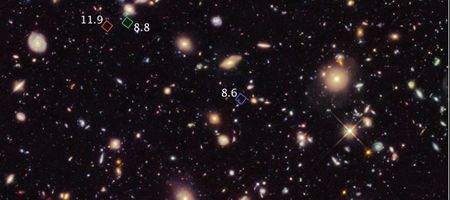Peering deep into the past, astronomers using the Hubble Space Telescope have identified seven primitive galaxies that formed more than 13 billion years ago, when the universe was less than three percent of its present age.

The newly-discovered galaxies are seen as they looked 350 million to 600 million years after the big bang.
The discovery gives scientists the clearest picture yet of the period when the very first galaxies were forming. It supports the idea that they were created continuously over time, and indicates that they may have provided enough radiation to reheat, or reionize, the universe a few hundred million years after the big bang.
A major goal of the new program was to determine how rapidly the number of galaxies increases over time in the early universe – key evidence for how quickly galaxies build up their constituent stars.
“Our study has taken the subject forward in two ways,” says Professor Richard Ellis of Caltech.
“First, we have used Hubble to make longer exposures than previously. The added depth is essential to reliably probe the early period of cosmic history. Second, we have used Hubble’s available color filters very effectively to more precisely measure galaxy distances.”
The team estimated the galaxy distances by studying their colors through a set of four filters at specific near-infrared wavelengths.
“We added an additional filter, and undertook much deeper exposures in some filters than in earlier work in order to convincingly reject the possibility that some of our galaxies might be foreground objects,” says James Dunlop of the University of Edinburgh.
The results indicate that there may be many more galaxies even deeper in space – some, perhaps, to be discovered by the Webb telescope.
“Although we may have reached back as far as Hubble will see, Hubble has, in a sense, set the stage for Webb,” says Anton Koekemoer of the Space Telescope Science Institute. “Our work indicates that there may be a rich field of even earlier galaxies that Webb will be able to study.”
Astronomers have long debated whether hot stars in such early galaxies could have provided enough radiation to warm the cold hydrogen that formed soon after the big bang. This process, called reionization, made the universe transparent to light, and is thought to have occurred 200 million to a billion years after the big bang.
“Observations of the microwave afterglow from the big bang tell us that reionization happened more than about 13 billion years ago,” says Brant Robertson of the University of Arizona inson.
“Our data confirms that reionization was a drawn-out process occurring over several hundred million years with galaxies slowly building up their stars and chemical elements. There wasn’t a single dramatic moment when galaxies formed; it was a gradual process.”






